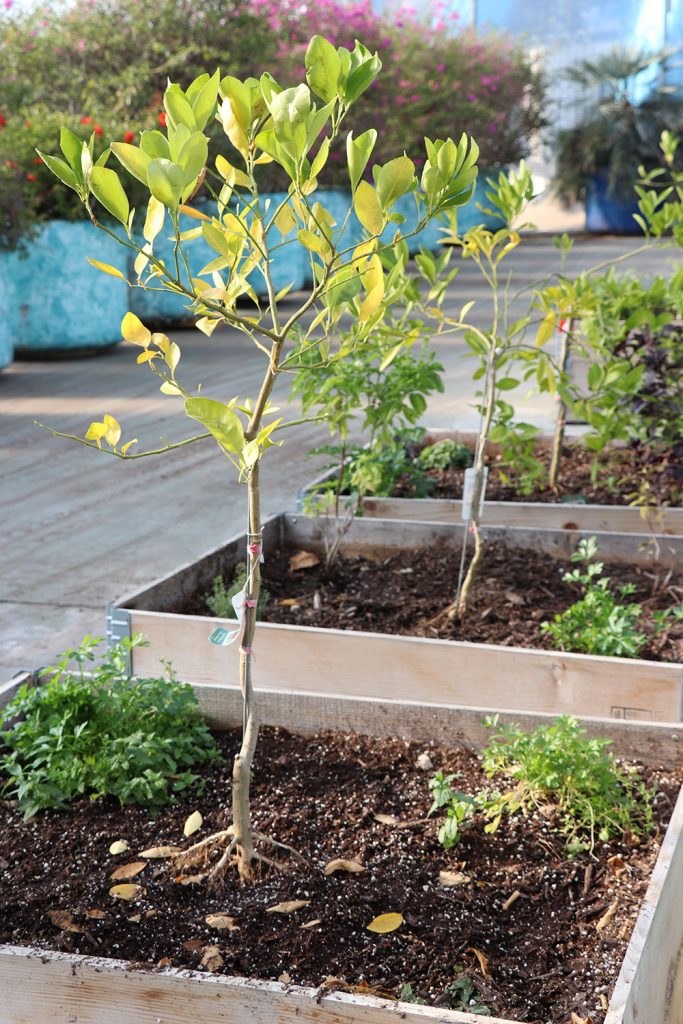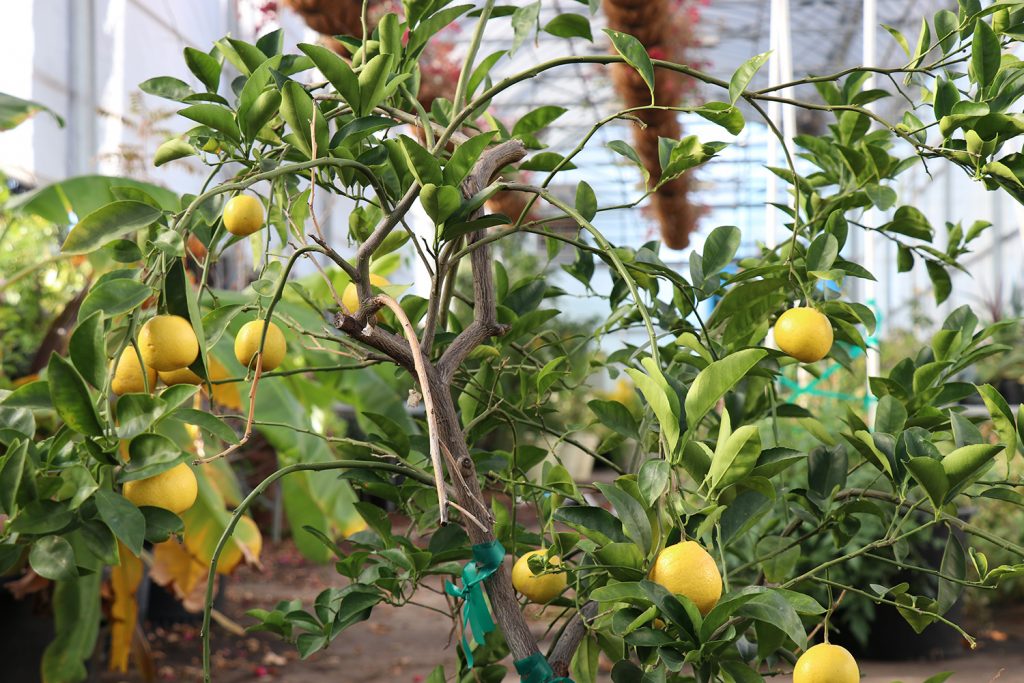Growing your own citrus tree can be a rewarding pleasure for a North Texas gardener. Not only are homegrown citrus fruit a real treat, but the tree itself can make a handsome addition to a patio or garden. With the “grow your own” movement in full swing, I decided to share with you my experiences with growing citrus in Texas.
Citrus trees can be relatively easy and pain-free to grow in North Texas. There are few pest and disease pressures that affect citrus in this part of the country, plus birds and squirrels don’t favor the fruit, which is very rare! The biggest concern with citrus trees in our area is keeping them warm enough in the winter. Most citrus can withstand temperatures as low as about 28 degrees, with certain varieties able to withstand 25 degrees. With a good strategy, it isn’t difficult to overwinter citrus.

Citrus Trees Growing at the Big Tex Urban Farms/Staff Photographer: Jessie Wood
Winter-Proof Your Citrus Tree
So, how do you grow your citrus trees to withstand the winter weather? Simply grow them in containers and move them indoors for winter. You don’t need to have a greenhouse, sunroom, or anything special. You can simply pull your pots into a garage or any room that stays above freezing. Citrus trees in winter will only need occasional water, maybe once a week. When I lived in Austin, I used my garage to keep my citrus happy. In December, when the temps would drop below freezing, I would pull my trees into a cool garage. They would live there until spring when I would pull them out. Often the trees would lose their leaves over winter and would look terrible! No worries though; if the trees defoliate in winter, they will recover just fine the following spring.
Citrus trees have been grown in containers and overwintered indoors for centuries in Northern Europe. Monasteries and houses of privilege in France used basements and root sellers to house tangerines and large collections of Mediterranean citrus varieties. Wealthy British families often had orangeries, which were glass house additions specifically designed to grow citrus trees. Many of the orangeries housed famous citrus collections from around the world and were considered a true mark of privilege among the elite. There are records of large European citrus collections at least as far back as the 1700’s.
Which Variety Works Best for North Texas
There are many varieties of citrus that do well in North Texas. I am particularly fond of Satsuma mandarins. These are medium size “oranges” that are seedless and peel very easily. Satsumas are very popular in South Louisiana, where I am from. We looked forward to seeing them fresh at the market all year long! They ripen like clockwork at Thanksgiving and will stay good on the tree for the whole month of December. Satsumas are amazingly sweet, particularly after they have been kissed by a few cold nights. Meyer lemons do well here, too. They have fragrant flowers and quality large lemons that ripen in mid-winter. Meyer lemons are one of the only citruses that will continue to bloom even after they have has set fruit! They bloom off and on nearly year-round and are just as useful as an ornamental as they are for fruit production. Mexican limes, Ruby Red grapefruit, and oranges are excellent choices in North Texas. On the Big Tex Urban Farms, we are growing several different Mandarins in boxes and we have plans to add more citrus soon. I am including a list of some of my favorite varieties and their characteristics at the end of this blog.
Caring for your Citrus Tree
Citrus trees like a spot in full sun, but partial shade will also be just fine. Trees grown in a pot will need water regularly during the summer, maybe as much as once a day. Throughout the rest of the year, every few days will be fine. Be sure to check the moisture level in your pots every few days to determine when they need water. I recommend using a granular slow-release fertilizer to keep your trees productive. Seek out fertilizers made specifically for citrus trees. Follow the directions on the bag of fertilizer you decide to use. Minor insect/pest issues are easily solved with an organic pesticide.

Citrus Trees Growing at the Big Tex Urban Farms/Staff Photographer: Jessie Wood
A List of a Few of My Favorite Citrus Varieties:
Miho Satsuma – One of the sweetest mandarins. Easy to peel. Very productive trees. I have a tree that I have grown for over twelve years now, and it still produces good fruit. Other great Satsumas include Owari, Brown Select, and Silver Hill. All Satsumas are great quality and well worth growing.
Meyer Lemon – A large, very productive, mild-flavored lemon. These are adored as much for the fragrant blossoms as they are for the fruit. They can take more cold temperatures than an average lemon, down to at least 27 degrees for short periods of time.
Mexican Lime – These are also known as Key limes. They are small, round, and full of flavor. Nothing tastes better in a cold beer, or so I’m told! Mexican limes are usually the first citrus to ripen in Texas – usually ready in mid-August.
Washington Navel Orange – The standard navel that is sold in grocery stores everywhere. It is a top quality seedless orange. Sometimes trees tend to bear fruit every other year. N-33 is another good navel for Texas, as is Cara Cara. The latter has pink flesh! Oranges ripen in December in Texas.
Hamlin Round Orange – This is not a navel, but a standard round orange. They are not seedless but are delicious nontheless! If you can find it, ‘Louisiana Sweet’ is one of the very best quality oranges I have ever tasted and is a Hamlin type.
Rio Red Grapefruit – The variety of citrus that made the Texas valley a legend. In my opinion, this is the best and sweetest grapefruit you can grow. The trees are productive and sport some of the most fragrant blossoms of all citrus. Grapefruits ripen a little later than other citrus and are usually not at their peak until January. There are many varieties of grapefruits to choose from including Bloom Sweet, Golden, and Ruby Red.
A few other oddballs to consider include a sweet lemon called Ujukitsu, Tangelos, and a grapefruit relative called Pummelo. The Ujukitsu fruit tastes exactly like lemonade! I have had one for years and really enjoy the novelty of it.
Citrus trees are fun to grow. Planting them in a pot and moving them inside for winter will keep them happy. Just follow the care tips in this blog, and you will be rewarded with a great harvest of citrus year after year! Until next time, happy gardening!
